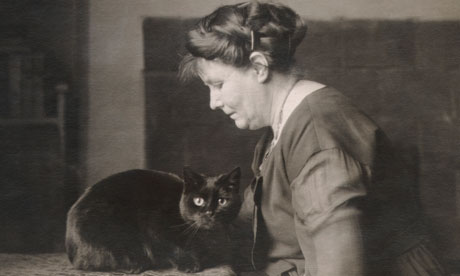
The "Men of 1914" – writers such as James Joyce, Ezra Pound, TS Eliot and DH Lawrence – are as much the poster boys of modernism today as they were when Wyndham Lewis coined the phrase in 1937. But 40 years of Virago's modern classics have shown that Virginia Woolf wasn't the only female author at the head of the literary vanguard, rediscovering and repositioning the differing visions of modernity offered by writers such as Dorothy Richardson and Rebecca West. But despite Virago's efforts, and her central role in the modernist revolution, May Sinclair remains shrouded in obscurity.
Sinclair was not only a critically-respected, popular and extremely prolific novelist, but also a poet, philosopher, translator, and critic. Her career, spanning from the late 1880s all the way to the late 1920s, produced 23 novels, 39 short stories, two philosophical treatises, one biography of the Brontës and several poetry collections.
She is perhaps vaguely recalled, by literature students at least, for her review of Dorothy Richardson's Pilgrimage in 1918 in which she coined the literary version of the phrase "stream of consciousness", or alternatively her remarkably perceptive early review of TS Eliot's "Love Song of J Alfred Prufrock". Less appreciated by most, however, is Sinclair's pivotal role in that early modernist milieu. She provided patronage to the young Ezra Pound and introduced him to Ford Madox Ford, an old friend of hers who as editor of the English Review would be the first to publish Pound's poems in England. She was good friends with Thomas Hardy, Henry James, HG Wells, Rebecca West and others, and was heavily involved with movements as diverse as women's suffrage, early psychoanalysis and imagist poetry.
These myriad influences are filtered and distilled in her fiction, which displays many of the tenets we would now deem to be modernist – stream-of-consciousness narration, temporal dislocation and discursive fragmentation – while at the same time remaining fundamentally readable. Sinclair's masterpiece, The Life and Death of Harriett Frean (1922), for example, tells the story of one woman's life from birth to death in a refreshingly short and accessible 160 pages. It is a "small, perfect gem of a book", according to Jonathan Coe, who praised the novel's "tragic force" and the "reserve of authorial compassion we can sense in the gaps between each fragmentary episode and every terse, clipped sentence". Harriett's life of self-denial is Sinclair's indictment of a society which demanded women should turn themselves into self-sacrificing nonentities obsessed with pursuing "moral beauty" instead of self-fulfilment. Looking back on her life in middle age, Harriett finally realises how she has been complicit in her own subjugation and succumbs to despair:
The years passed. They went with an incredible rapidity, and Harriet was now fifty. The feeling of insecurity had grown on her … She had no clear illumination, only a mournful acquiescence in her own futility, an almost physical sense of shrinkage, the crumbling away, bit by bit, of her beautiful and honourable self.
The characteristically elliptical brevity of those first sentences, Sinclair's experiment in translating imagist poetic principles to prose, can be seen as the precursor – or, depending on your point of view, the antidote – to the great and at times intimidatingly unwieldy modernist novels of the 1920s, Mrs Dalloway and Ulysses.
Yet, for all its merits, this is the only one of Sinclair's novels currently in print. The Three Sisters (1914) – an atmospheric re-imagination of the Brontë story – and Mary Olivier (1919) – a quintessentially modernist "portrait of the artist as young (wo)man" published just as Joyce, Richardson and Woolf were also making their first forays into stream-of-consciousness prose – were both published by Virago in the 1980s, but both have since dropped from view. Earlier novels such as The Tysons (1898), The Divine Fire (1904) and The Creators (1910) – the latter the first novel to represent writing as a potentially central occupation of women's lives – have never been reprinted, despite their consummate artistry and insightful social and psychological realism.
For such an accomplished author, to have just one novel circulating in the 21st century is appalling. Sinclair was never a self-promoter (unlike most of her contemporaries) and seems to have suffered the consequences – there is no brash polemic, like Ezra Pound's "make it new" or Wyndham Lewis's incessant "blasting", to act as a platform from which all of her work appears radical or holistically comprehensible.
Indeed, perhaps the disadvantage of spanning such a wide timescale is that Sinclair's work is constantly changing and adapting to new conditions and ideas; her early New Woman novels bear little resemblance to her later modernist works, though there is little difference in quality. Instead, her fiction is infused with a plethora of influences, and it is this eclectic synthesis, rather than pure originality, which is Sinclair's strength. While academic circles are plagued with anxiety about whether such a popular and approachable author can ever be quite "literary" enough, she falls uncomfortably into the gap between the two. Whatever the reasons for her neglect, it has become a vicious circle: not being read means things go out of print, which means they're not read, which means they stay out of print …
But there are glimmers of hope. Sinclair's complete works are available on Project Gutenberg, and the May Sinclair Society, launched this month, will be organising discussions, conferences and yes, some long overdue new editions of her works. Perhaps this archetypal modernist will be rescued by that most modern of inventions, the internet.

